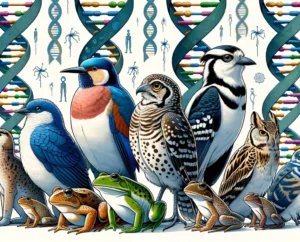In the world of biology, understanding the intricacies of genetic inheritance is paramount. One fascinating phenomenon that plays a crucial role in this process is crossing over. This article delves into the definition, functions, and mechanisms of crossing over, shedding light on its significance in genetics.

✅ AI Essay Writer ✅ AI Detector ✅ Plagchecker ✅ Paraphraser
✅ Summarizer ✅ Citation Generator
Defining Crossing Over
At its core, crossing over is the exchange of genetic material between non-sister chromatids of homologous chromosomes during meiosis. This genetic exchange leads to the creation of novel allelic combinations in the resulting daughter cells. To fully grasp the significance of crossing over, we need to delve deeper into its mechanisms and functions.
The process of crossing over begins with a double-strand break in one of the DNA molecules. This break can occur naturally due to various factors, such as radiation or specific proteins. Subsequently, enzymes known as exonucleases remove short stretches of nucleotides from the DNA strands in a specific orientation. This results in two single-stranded regions.
These single-stranded regions are coated with proteins that catalyze recombination, or the exchange of genetic material. During prophase I of meiosis, homologous chromosomes align with each other, creating an opportunity for these single-stranded regions to invade sequences suitable for base pairing. This process generates recombinant chromosomes, which contain a mixture of genes from both the maternal and paternal chromosomes.
Functions of Crossing Over
Crossing over serves several vital functions in the world of genetics. One of its primary roles is to increase the variability of a population. In sexually reproducing organisms, genetic diversity is essential for adapting to changing environments and responding to selective pressures.
Moreover, crossing over helps prevent the accumulation of deleterious combinations of alleles. Without this mechanism, asexual reproduction would lead to a condition known as Muller’s Ratchet, where each generation carries at least as many genetic mutations as the previous one, if not more. In such scenarios, there would be no opportunity for genetic errors to be corrected or for beneficial combinations to emerge.
Homologous Chromosomes and Genetic Inheritance
To understand crossing over fully, we must first appreciate the concept of homologous chromosomes. These are pairs of chromosomes, each derived from one parent, and they carry similar genetic information. During meiosis, homologous chromosomes align with each other, setting the stage for crossing over.
Diploid cells, which are found in most parts of an organism’s body, contain two copies of every chromosome. This means they carry two sets of genes that determine the sequence of nearly every RNA or protein. In contrast, haploid cells, such as male and female gametes, contain only one complete set of chromosomes. The fusion of two haploid gametes during fertilization results in a diploid zygote.
While homologous chromosomes carry the same genes, slight differences can exist in their DNA sequences. These differences can lead to variations in traits and characteristics. Crossing over plays a pivotal role in reshuffling these genetic variations, ensuring genetic diversity in offspring.
The Importance of Meiosis
The process of crossing over occurs during meiosis, a specialized form of cell division essential for sexual reproduction. Meiosis consists of two stages: meiosis I and meiosis II. It is during prophase I of meiosis I that crossing over takes place.
Meiosis I, also known as reduction division, results in the formation of two haploid daughter cells from a diploid parent cell. These daughter cells possess only one complete set of duplicated chromosomes, which is crucial for the formation of gametes.
During prophase I, chromosomes undergo condensation, and homologous chromosomes come together due to their structural similarity and centromere positioning. This alignment is critical for the subsequent crossing over event.
The Significance of Genetic Diversity
Genetic diversity is the key to the survival and adaptation of species. It allows organisms to respond to environmental changes and challenges. Crossing over contributes significantly to this diversity by creating new allelic combinations in offspring.
Imagine a population of organisms where every individual is genetically identical. In such a scenario, there would be no scope for genetic errors to be corrected, and the population would be vulnerable to adverse mutations. Crossing over helps maintain potentially useful allelic combinations while introducing variations that can lead to evolutionary changes.
Conclusion
In the intricate world of genetics, crossing over stands as a remarkable mechanism that enhances genetic diversity and ensures the survival of species. It is a fundamental process that occurs during meiosis, enabling the creation of novel allelic combinations in daughter cells. By reshuffling genetic material and preventing the accumulation of deleterious mutations, crossing over plays a crucial role in the evolution and adaptation of living organisms. Understanding this process is essential for unraveling the mysteries of genetic inheritance in biology.
FAQ
Follow us on Reddit for more insights and updates.





Comments (0)
Welcome to A*Help comments!
We’re all about debate and discussion at A*Help.
We value the diverse opinions of users, so you may find points of view that you don’t agree with. And that’s cool. However, there are certain things we’re not OK with: attempts to manipulate our data in any way, for example, or the posting of discriminative, offensive, hateful, or disparaging material.